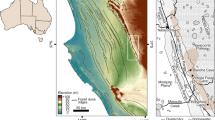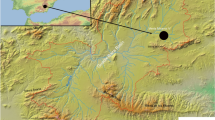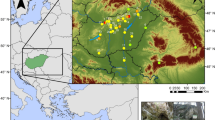Abstract
The Cradle of Humankind (Cradle) in South Africa preserves a rich collection of fossil hominins representing Australopithecus, Paranthropus and Homo1. The ages of these fossils are contentious2,3,4 and have compromised the degree to which the South African hominin record can be used to test hypotheses of human evolution. However, uranium–lead (U–Pb) analyses of horizontally bedded layers of calcium carbonate (flowstone) provide a potential opportunity to obtain a robust chronology5. Flowstones are ubiquitous cave features and provide a palaeoclimatic context, because they grow only during phases of increased effective precipitation6,7, ideally in closed caves. Here we show that flowstones from eight Cradle caves date to six narrow time intervals between 3.2 and 1.3 million years ago. We use a kernel density estimate to combine 29 U–Pb ages into a single record of flowstone growth intervals. We interpret these as major wet phases, when an increased water supply, more extensive vegetation cover and at least partially closed caves allowed for undisturbed, semi-continuous growth of the flowstones. The intervening times represent substantially drier phases, during which fossils of hominins and other fossils accumulated in open caves. Fossil preservation, restricted to drier intervals, thus biases the view of hominin evolutionary history and behaviour, and places the hominins in a community of comparatively dry-adapted fauna. Although the periods of cave closure leave temporal gaps in the South African fossil record, the flowstones themselves provide valuable insights into both local and pan-African climate variability.
This is a preview of subscription content, access via your institution
Access options
Access Nature and 54 other Nature Portfolio journals
Get Nature+, our best-value online-access subscription
$29.99 / 30 days
cancel any time
Subscribe to this journal
Receive 51 print issues and online access
$199.00 per year
only $3.90 per issue
Buy this article
- Purchase on Springer Link
- Instant access to full article PDF
Prices may be subject to local taxes which are calculated during checkout


Similar content being viewed by others
Data availability
The authors declare that all data supporting the findings of this study are available within the paper and the Supplementary Information (see Supplementary Information and Supplementary Table 1).
References
Wood, B. & Boyle, E. K. Hominin taxic diversity: fact or fantasy? Am. J. Phys. Anthropol. 159, 37–78 (2016).
Herries, A. I. R. & Shaw, J. Palaeomagnetic analysis of the Sterkfontein palaeocave deposits: implications for the age of the hominin fossils and stone tool industries. J. Hum. Evol. 60, 523–539 (2011).
Granger, D. E. et al. New cosmogenic burial ages for Sterkfontein Member 2 Australopithecus and Member 5 Oldowan. Nature 522, 85–88 (2015).
Kramers, J. D. & Dirks, P. H. G. M. The age of fossil StW573 (‘Little Foot’): an alternative interpretation of 26Al/10Be burial data. S. Afr. J. Sci. 113, 2016-0085 (2017).
Pickering, R., Kramers, J. D., Partridge, T., Kodolanyi, J. & Pettke, T. U–Pb dating of calcite–aragonite layers in speleothems from hominin sites in South Africa by MC-ICP-MS. Quat. Geochronol. 5, 544–558 (2010).
Ayliffe, L. K. et al. 500 ka precipitation record from southeastern Australia: evidence for interglacial relative aridity. Geology 26, 147–150 (1998).
Pickering, R. et al. Stratigraphy, U–Th chronology, and paleoenvironments at Gladysvale Cave: insights into the climatic control of South African hominin-bearing cave deposits. J. Hum. Evol. 53, 602–619 (2007).
Dart, R. Australopithecus africanus: the man-ape of South Africa. Nature 115, 195–199 (1925).
Vrba, E. S. in Hominid Evolution. Past, Present and Future (ed. Tobias, P. V.) 195–200 (Alan R. Liss, New York, 1985).
Potts, R. Variability selection in hominid evolution. Evol. Anthropol. 7, 81–96 (1998).
Behrensmeyer, A. K., Todd, N. E., Potts, R. & McBrinn, G. E. Late Pliocene faunal turnover in the Turkana basin, Kenya and Ethiopia. Science 278, 1589–1594 (1997).
Trauth, M. H., Larrasoaña, J. C. & Mudelsee, M. Trends, rhythms and events in Plio-Pleistocene African climate. Quat. Sci. Rev. 28, 399–411 (2009).
deMenocal, P. B. Climate and human evolution. Science 331, 540–542 (2011).
Walker, J., Cliff, R. A. & Latham, A. G. U–Pb isotopic age of the StW 573 hominid from Sterkfontein, South Africa. Science 314, 1592–1594 (2006).
Pickering, R., Kramers, J. D., Hancox, P. J., de Ruiter, D. J. & Woodhead, J. D. Contemporary flowstone development links early hominin bearing cave deposits in South Africa. Earth Planet. Sci. Lett. 306, 23–32 (2011).
Brain, C. K. in Paleoclimate and Evolution, with Emphasis on Human Origins (eds Vrba, E. S. G. et al.) 451–458 (Yale Univ. Press, New Haven, 1995).
Woodhead, J. et al. U–Pb geochronology of speleothems by MC-ICPMS. Quat. Geochronol. 1, 208–221 (2006).
McDougall, I. et al. New single crystal 40Ar/39Ar ages improve time scale for deposition of the Omo Group, Omo–Turkana Basin, East Africa. J. Geol. Soc. Lond. 169, 213–226 (2012).
Vermeesch, P. On the visualisation of detrital age distributions. Chem. Geol. 312–313, 190–194 (2012).
Dirks, P. H. G. M. et al. The age of Homo naledi and associated sediments in the Rising Star Cave, South Africa. eLife 6, e24231 (2017).
de Ruiter, D. J., Brophy, J. K., Lewis, P. J., Churchill, S. E. & Berger, L. R. Faunal assemblage composition and paleoenvironment of Plovers Lake, a Middle Stone Age locality in Gauteng Province, South Africa. J. Hum. Evol. 55, 1102–1117 (2008).
Gibbon, R. J. et al. Cosmogenic nuclide burial dating of hominin-bearing Pleistocene cave deposits at Swartkrans, South Africa. Quat. Geochronol. 24, 10–15 (2014).
Herries, A. I. R. et al. in Paleobiology of Australopithecus (Vertebrate Paleobiology and Paleoanthropology Series) (eds Reed, K. E. et al.) 21–40 (Springer Netherlands, Dordrecht, 2013).
Eldredge, N. & Gould, S. J. in Models in Paleobiology (ed. Schopf, T. J. M.) 82–115 (Freeman, Cooper & Co, San Francisco, 1972).
Vrba, E. S. in Ancestors: The Hard Evidence (ed. Delson, E.) 63–71 (Alan R. Liss, New York, 1985).
Vrba, E. S. Mammals as a key to evolutionary theory. J. Mamm. 73, 1–28 (1992).
Herries, A. I. R. et al. Geoarchaeological and 3D visualisation approaches for contextualising in-situ fossil bearing palaeokarst in South Africa: a case study from the ~2.61 Ma Drimolen Makondo. Quat. Int. 483, 90–110 (2018).
Lisiecki, L. E. & Raymo, M. E. A Pliocene-Pleistocene stack of 57 globally distributed benthic δ18O records. Paleoceanography 20, PA1003 (2005).
Pickering, R. et al. Australopithecus sediba at 1.977 Ma and implications for the origins of the genus Homo. Science 333, 1421–1423 (2011).
Paton, C., Hellstrom, J., Paul, B., Woodhead, J. & Hergt, J. Iolite: freeware for the visualisation and processing of mass spectrometric data. J. Anal. At. Spectrom. 26, 2508–2518 (2011).
Schmitz, M. D. & Schoene, B. Derivation of isotope ratios, errors, and error correlations for U–Pb geochronology using 205Pb–235U–(233U)-spiked isotope dilution thermal ionization mass spectrometric data. Geochem. Geophys. Geosyst. 8, Q08006 (2007).
Dirks, P. et al. Geological setting and age of Australopithecus sediba from Southern Africa. Science 328, 205–208 (2010).
de Ruiter, D. J. et al. New Australopithecus robustus fossils and associated U–Pb dates from Cooper’s Cave (Gauteng, South Africa). J. Hum. Evol. 56, 497–513 (2009).
Wynn, J. G. Influence of Plio-Pleistocene aridification on human evolution: evidence from paleosols of the Turkana Basin, Kenya. Am. J. Phys. Anthropol. 123, 106–118 (2004).
Trauth, M. H., Maslin, M. A., Deino, A. & Strecker, M. R. Late Cenozoic moisture history of east Africa. Science 309, 2051–2053 (2005).
Maslin, M. A. & Trauth, M. H. in The First Humans: Origins of the Genus Homo (eds Grine, F. E. et al.) 151–158 (Springer Netherlands, Dordrecht, 2009).
Potts, R. & Faith, J. T. Alternating high and low climate variability: the context of natural selection and speciation in Plio-Pleistocene hominin evolution. J. Hum. Evol. 87, 5–20 (2015).
Acknowledgements
We thank D. Braun, R. Potts, B. Wood and W. L. S. Joe for their insightful discussion. Site access granted by C. Steininger, R. Clarke, T. Pickering, C. Menter, S. Potze, J. Adams and L. Berger; permits provided by South African Heritage Resource Agency. This work was supported by Australian Research Council DECRA DE120102504 (to R.P.), University of Melbourne McKenzie Post-Doctoral Fellowship 0023249 (to R.P.), Australian Research Council Future Fellowship FT120100399 (to A.I.R.H.) and Discovery Project DP170100056 (to A.I.R.H. and D.S.S.) and National Science Foundation Grant BCS 0962564 (to A.I.R.H.) .
Reviewer information
Nature thanks C. Feibel, T. Rasbury and the other anonymous reviewer(s) for their contribution to the peer review of this work.
Author information
Authors and Affiliations
Contributions
R.P. devised the project, conducted the U–Pb dating, drafted and revised the manuscript; A.I.R.H. assisted in the project design, fieldwork and site access; J.D.W., J.C.H., H.E.G. and B.P. assisted with U–Pb and 234U/238U analysis, data processing and discussion; T.R. and D.S.S. contributed to the hominin discussion; B.J.S. assisted with data visualization, including Supplementary Video 1 and discussion; P.J.H. contributed to the conceptual design of the project and provided field support. All authors contributed equally to the paper.
Corresponding author
Ethics declarations
Competing interests
The authors declare no competing interests.
Additional information
Publisher’s note: Springer Nature remains neutral with regard to jurisdictional claims in published maps and institutional affiliations.
Extended data figures and tables
Extended Data Fig. 1 Field photographs showing U–Pb-dated flowstone from the indicated sites, all of which record some variation of an alternating stack of flowstones and fossil-bearing sediments.
a, The basal flowstone from Cooper’s Cave. b, c, Flowstones at Haasgat are preserved in the now-deroofed section of the deposits (b) and inside the cave (c). d, The flowstone capping the MB1 Lower Bank at Swartkrans. e, f, Flowstone from Bolt’s Farm Pit 7 at the base (e) and top (f) of the sequence. g, Flowstone capping Member 4 at Sterkfontein. h, Flowstone underlying fossil bearing sediments at Malapa. i, Flowstone sandwiched between fossil-bearing sediments at Drimolen. j, Massive flowstone at the base of Member 4 at Sterkfontein is exposed in a borehole. k, Flowstone underlying fossil-bearing sediments at Hoogland.
Extended Data Fig. 2 U–Pb ages plotted against time and by site, additional un-U–Pb dated Cradle sites and non-Cradle hominin cave sites included.
a–e, A variation of Fig. 2. U–Pb ages of Cradle sites are shown, with Cradle sites not dated with U–Pb (Gondolin and Kromdraai) included, as well as the non-Cradle hominin cave sites (Makapansgat and Taung) shown for comparison. All U–Pb ages are plotted against time and by site, n = 29, diamonds represent individual ages and 2σ errors are shown as whiskers. Also included here are four records of climate and variability derived from orbital parameters for East African sites (d), specifically arid phases from soil carbonates34, periods of deep rift valley lakes35, phases of extreme climate variability36 and key phases of variability as described previously37. Again, there is no clear relationship between these records and the new South African flowstone record. Indicated data were obtained from previous studies28,34,35,36,37.
Supplementary information
Supplementary Discussion
Detailed discussion about the ages of the sedimentary fossil bearing units preserved in the Cradle caves.
Supplementary Table 1
All uranium and lead isotope concentration and ratio data needed for age calculations.
Supplementary Video 1
Animation showing the location and age distribution of speleothem samples at hominin bearing cave sites in the Cradle of Humankind between 3.200 and 1.332 million years ago.
Rights and permissions
About this article
Cite this article
Pickering, R., Herries, A.I.R., Woodhead, J.D. et al. U–Pb-dated flowstones restrict South African early hominin record to dry climate phases. Nature 565, 226–229 (2019). https://doi.org/10.1038/s41586-018-0711-0
Received:
Accepted:
Published:
Issue Date:
DOI: https://doi.org/10.1038/s41586-018-0711-0
Keywords
This article is cited by
-
Reply to: Clusters of flowstone ages are not supported by statistical evidence
Nature (2021)
-
Intrataxonomic trends in herbivore enamel δ13C are decoupled from ecosystem woody cover
Nature Ecology & Evolution (2021)
-
Clusters of flowstone ages are not supported by statistical evidence
Nature (2021)
-
Sacrum morphology supports taxonomic heterogeneity of “Australopithecus africanus” at Sterkfontein Member 4
Communications Biology (2021)
-
Environmental drivers of megafauna and hominin extinction in Southeast Asia
Nature (2020)
Comments
By submitting a comment you agree to abide by our Terms and Community Guidelines. If you find something abusive or that does not comply with our terms or guidelines please flag it as inappropriate.



